ASM Summer Student Research Awards: 2021
Priscilla JohanesenChair, ASM Standing Committee for Professional Development
Microbiology Australia 42(3) 142-147 https://doi.org/10.1071/MA21040
Published: 15 September 2021
Journal Compilation © The Authors 2021 Open Access CC BY-NC-ND, published (by CSIRO Publishing) on behalf of the ASM

|
There is no time like the present to foster the development of future microbiology researchers. The ASM Summer Student research awards are a fantastic opportunity for students to join a research group and experience what is like to work in a research environment. This year the society awarded more summer student awards than ever before with national office and the state branches together offering seventeen ASM Summer Student Research Awards across Australia. As in previous years the microbiology research projects that students undertook represented the diversity of the discipline across food, veterinary and medical microbiology. This year the successful awardees were: Callum Kay, Daniel Neville, Lucy O’Shannessy and Tsung-Yu Pai from New South Wales; Daniel Ellis, Jin Gu and Stephen Carpenter from Queensland; Jack Waters from South Australia; Naomi Foo and Primrose Mandalawatta from Tasmania; Jacinta Agius, Taylah James, Sameer Mohammad Khan and Cecil Wheeler from Victoria, and Jake Cummane, Merrin Mary Eapen and Beatrice Alexandra E. Panganiban from Western Australia. The society would like to congratulate all of the winners of the 2021 Summer Student Research Awards and wish them all the best for the future.
New South Wales
NLRP3 inflammasome activation by the bacterial toxin phospholipase C

|
Callum KayA,B and Si Ming ManA
ADepartment of Immunology and Infectious Disease, The John Curtin School of Medical Research, The Australian National University, Australian Capital Territory, Australia
BMedical School, The Australian National University, Australian Capital Territory, Australia
Inflammasome signalling is a central pillar of innate immunity leading to inflammation and cell death. Identifying and characterising new activators of the inflammasome is critical in elucidating the molecular basis of innate immune recognition of pathogens and to inform the development of novel therapeutics. Previously, I screened a panel of toxins from phylogenetically diverse organisms and identified phospholipase C (PLC) from the bacterial pathogen Clostridium perfringens as an activator of the NLRP3 inflammasome. My existing data suggest that phagocytosis and endo-lysosomal trafficking of the toxin are required for PLC-mediated inflammasome activation. PLC then likely induces lysosomal membrane disruption and potassium efflux as a signal to trigger NLRP3 inflammasome assembly. In this study, I obtained new data to strengthen this model. In particular, I used correlative light and electron microscopy to demonstrate that PLC localised with vesicular structures resembling lysosomes in macrophages. I also verified PLC as a bona fide NLRP3 activator using recombinant PLC produced by an alternative commercial source. Additionally, I examined the role of the plasma membrane rupture mediator protein NINJ1 in PLC-mediated cell death. Together, these data further elucidate the mechanism by which a pathogen-derived phospholipase can be detected by the mammalian innate immune system.
The alcohol dehydrogenase adhE encodes a regulatory small RNA within the 3′UTR that is induced by heat shock in enterohaemorrhagic E. coli
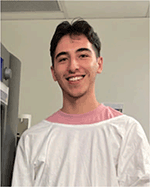
|
Daniel Neville, Brandon Sy and Jai Tree
School of Biotechnology and Biomolecular Sciences, UNSW, New South Wales, Australia
Enterohaemorrhagic E. coli (EHEC) is the most prevalent etiological agent of infectious haemolytic uremic syndrome. EHEC elaborates a Shiga toxin that antagonises the renal endothelium, preventing protein synthesis that leads to cell apoptosis and potentially renal failure. Post-transcriptional regulation plays an important role in EHEC pathogenesis and is controlled by regulatory small RNAs (sRNA). A novel sRNA (here termed AdhU) was identified within the 3′UTR of the highly conserved bifunctional aldehyde/alcohol dehydrogenase AdhE. Deletion of adhE attenuates EHEC pathogenesis. The mechanism of this attenuation is unknown, and we hypothesise that AdhU may play an important role in virulence gene regulation. Here we have demonstrated that RNase E is not required for the AdhU biogenesis but in doing so, observed heat shock-dependent induction of AdhU expression in EHEC. This indicates that AdhU is controlled by a heat shock responsive promoter. We have used RLM-RACE to verify the presence of multiple RNA 5′-ends upstream of the adhE 3′UTR and RNA-seq experiments to identify the regulatory targets of AdhU are ongoing. These are expected to further elucidate the role of AdhU in EHEC pathogenesis.
Investigation of mechanism of phagocytosis of Coxiella burnetii by bovine mammary epithelial cells

|
Lucy O’Shannessy, Katrina Bosward and Paul Sheehy
The University of Sydney, New South Wales, Australia
Q fever is a globally important zoonotic disease caused by the bacterium Coxiella burnetii. Livestock are reservoirs for human infection, with shed bacteria transmitted primarily via inhalation of contaminated aerosols, while ingestion is a less common and poorly understood transmission route. Coxiella burnetii shows high prevalence in unpasteurised dairy products worldwide, thereby presenting a possible public health risk. Bovine mammary epithelial cells (bMECs) have been hypothesised to be a replicative niche in the mammary gland, hence this study aimed to characterise the mechanism mediating their uptake of C. burnetii. Expression of Leukocyte Response Integrin (αVβ3) and Complement Receptor 3 (CR3) (receptors mediating uptake in phagocytic cells) was confirmed on the bMEC line, MAC-T, in 2D and 3D organoid culture by immunohistochemical analysis, using monoclonal antibodies targeting CD61 and CD11b (integrins forming αVβ3 and CR3, respectively). A phagocytosis assay was then conducted by pre-incubating MECs with antibody to block αVβ3 and CR3, followed by inoculation with fixed and fluorescently labelled Nine Mile phase II (Clone 4) C. burnetii. Despite co-incubation with antibody, C. burnetii was still taken up, highlighting the complexity of the uptake mechanism. Future work is required to optimise the competitive inhibition model and allow characterisation of uptake mechanisms.
Metal-based antifungal drug testing in insect model (Galleria mellonella)

|
Tsung-Yu PaiA,B, Wieland MeyerB and Alex KanB
AUniversity of Technology Sydney, New South Wales, Australia
BMolecular Mycology Research Laboratory, Centre for Infectious Diseases and Microbiology, Faculty of Medicine and Health, Sydney Medical School, Westmead Clinical School, Marie Bashir Institute for Infectious Diseases and Biosecurity, The University of Sydney, Westmead Hospital, Research and Education Network, Westmead Institute for Medical Research, Westmead, New South Wales, Australia
Upon the search for novel antimicrobials due to the urgent need for new therapeutic mechanisms to address the pressing issue of antibiotic resistance, cobalt-based complexes were found to present antifungal activity in vitro in previous work. Various cobalt complexes were tested by Tsung-Yu Pai together with Alex Kan under the supervision of Prof. Wieland Meyer (Molecular Mycology Research Laboratory, Centre for Infectious Diseases and Microbiology, Westmead Institute for Medical Research) for the therapeutic effect against four clinically important fungal species (Candida albicans, C. auris, Cryptococcus gattii and C. neoformans) in the moth larval model, Galleria mellonella. Due to the short timeframe and the limited moth larvae supply, only two test compounds could be tested once. The result showed no significant difference in the survival rates of moth larvae between fluconazole treated and non-treated groups. Therefore, in subsequent experiments the optimal inoculating concentrations of the fungal strains need to be refined, more replicates will need to be conducted, and additional compounds will be included.
Queensland
Genomic diversity and potential antimicrobial targets in non-typeable Haemophilus influenzae
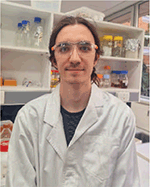
|
Daniel Ellis and Ulrike Kappler
School of Chemistry and Molecular Biosciences, The University of Queensland, Queensland, Australia
Antimicrobial resistance is an increasing concern in the human specific respiratory pathobiont, Haemophilus influenzae (NTHi), with the WHO naming NTHi as a priority pathogen for the development of new antimicrobial therapies. A possible new antimicrobial target in NTHi may be the sulfoxide reductase HiDmsABC, which has previously been shown in our lab to be important for host-pathogen interactions despite its substrate being unknown. Here we have looked at the genomic diversity of NTHi and the distribution of dmsABC genes within NTHi genomes, as well as characterised the activity of HiDmsABC with several potential substrates that occur in the human respiratory tract. The results revealed that while NTHi is highly genetically diverse, with a core genome of 1258 genes and an accessory genome of 3453 genes, but HiDmsABC was found to be conserved across all genomes. HiDmsABC showed promising activity with several of the substrates tested with KM values in physiologically relevant ranges, suggesting several possible roles for HiDmsABC in supporting virulence.
Investigation into the role of metal homeostasis in Haemophilus influenzae
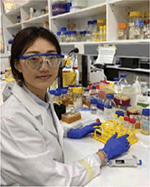
|
Jin Gu and Ulrike Kapplert
School of Chemistry and Molecular Biosciences, The University of Queensland, Queensland, Australia
Haemophilus influenzae (Hi) causes a variety of respiratory diseases and is highly resistant to reactive oxygen species which are generated by human immune cells. Mn ions have been implicated in oxidative stress resistance, and Mn uptake in H. influenzae relies on the PsaABCD, ABC-type Mn transporter. Mn (II) ions serve as a cofactor of superoxide dismutase (SOD), and the cellular abundance of manganese regulates the activity of SOD. In the project, a mutation in the psaA gene was complemented, which reversed the sensitivity to superoxide stress observed for Hi2019ΔpsaA to wildtype (WT) levels, proving that Mn uptake is essential for oxidative stress resistance in H. influenzae. Despite this, following growth on Brain-Heart Infusion medium, no difference in SOD activity was observed for the WT and mutant strain. We propose that this may be due to relatively high content Mn in this medium that may have compensated for reduced uptake rates. It is likely that Mn may have been taken up from BHI medium via other, low specificity transport mechanisms.
Exploring bacterial transporters in antibiotic resistance in mycobacteria

|
Stephen Carpenter, Giorgia Mori and Antje Blumenthal
UQ Diamantina Institute, The University of Queensland, Queensland, Australia
Tuberculosis (TB) remains a major public health concern around the globe, with the prevalence of drug-resistant tuberculosis increasing at alarming rates. Efforts in defining improved and new treatment opportunities for TB include not only the search for new antibiotics, but also strategies for increasing the sensitivity of Mycobacterium tuberculosis (Mtb) to existing antibiotics. This project focused on molecular mechanisms by which antibiotics are transported into Mtb, specifically the contributions of proteins that actively transport cargo into bacterial cells. To this end, plasmids for the expression of Mtb candidate genes were generated and transformed into Mycobacterium bovis Bacille Calmette Guerin (BCG) to achieve bacterial clones that overexpress putative importers. Mtb gene expression in BCG clones was confirmed by qPCR. Select BCG clones were then assessed for their sensitivity to current TB antibiotics by determining minimum inhibitory concentrations (MIC) in a liquid culture assay. The preliminary observations arising from this summer project encourage further exploration of importers in the uptake of antibiotics and antimicrobials by Mtb.
South Australia
Regulating fatty acid acquisition in Acinetobacter baumannii
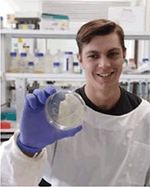
|
Jack Kenneth Waters and Bart Antonie Eijkelkamp
College of Science and Engineering, Flinders University, South Australia, Australia
Acinetobacter baumannii is an opportunistic nosocomial pathogen responsible for highly drug resistant infections. The World Health Organization has placed A. baumannii at the top of its list for the urgent development of new antimicrobials, highlighting a need to fully understand this unique pathogen. The bacterial membrane, which presents a primary barrier to antibiotic entry, has been overlooked in its role in resistance. In Gram-negative bacteria, environmental fatty acids are acquired foremost through the outer membrane protein FadL, but how this system is regulated, and its substrate preference is poorly understood. Analyses of distinct fatty acids in wild-type and a fadL mutant derivative confirmed a role in the acquisition of long-chain fatty acids in A. baumannii. The development of a fluorescent reporter system has provided novel insights into fadL regulation. Preliminary data suggests that fadL is regulated at the translational rather than transcriptional level, owed to a series of stem loops found in its upstream region. Overall, this placement project has identified that fadL is subjected to multilevel regulation, which is, at least in part, attuned to its substrate range.
Tasmania
Isolation and identification of bacteria and yeasts in kefir grain and milk kefir
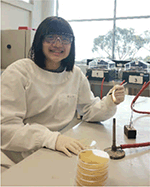
|
Naomi Foo, Faisal Abdulrahman J Alraddadi, John Bowman and Shane Powell
Centre for Food Safety and Innovation, Tasmanian Institute of Agriculture, University of Tasmania, Tasmania, Australia
To elucidate the composition and diversity of kefir grain microbiota, this study employed selective culturing techniques to isolate lactic acid bacteria (LAB), acetic acid bacteria (AAB) and yeast from kefir grains and at different stages of milk kefir fermentation, to be utilised in subsequent experiments. 16S rRNA gene sequencing was used to aid in the identification of the said isolates. Bacterial species known to be prevalent in kefir grains and milk kefir, Lactobacillus kefiranofaciens, Leuconostoc mesenteroides and Lactococcus lactis were detected. The primary lactose-fermenting and non-lactose fermenting yeasts Kluyveromyces marxianus and Torulaspora delbrueckii were also identified. These findings were in line with the results of previous studies, indicating that a portion of the kefir grain ecosystem is relatively stable. Minor bacterial species like Pseudomonas putida and Cephalothrix lacustris, which are believed to be environmental contaminants, were also isolated. However, no AAB were isolated possibly owing to low cell viability or lack of use of suitable selective media. Future studies employing a polyphasic approach to microbial detection and identification are necessary to overcome the limitations of culture-based techniques.
Pathogenic potential of Pandoraea fibrosis
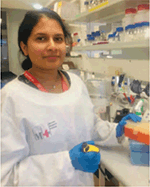
|
Primrose Mandalawatta and Louise Roddam
School of Medicine, University of Tasmania, Tasmania, Australia
Cystic fibrosis (CF) is an inherited life-limiting single gene disease in Caucasian populations and is caused by dysfunction or absence of the CFTR protein. This results in thickened mucus lining the airways and a propensity for people with CF to have lung infections with a variety of respiratory pathogens and inflammation. Pandoraea were recently described and are being increasingly isolated from CF clinical samples and are able to cause chronic infections, bacteraemia and probably contribute to damage and pulmonary decline. To-date, there have been 3 Tasmanian CF patients with documented Pandoraea lung infections. The first patient had two isolates collected and these isolates represented a new species, P. fibrosis. The newer isolates are yet to be assigned to a species. In this study the bacterial gyrB gene was used to determine species of these new isolates. The gyrB gene of isolate 366 has 98.81% sequence similarity to P. fibrosis and gyrB gene of isolates 511 and 329 has 99.45% sequence similarity to P. apista. 511 and 329 were 100% identical to each other, supporting these isolates as being clonal and associated with a chronic infection. Overall, this study also investigated biofilm formation and regulation by Pandoraea isolates and our results show that Pandoraea responds to exogenous QS signals, such as those produced by other CF pathogens even if unable to synthesise their own.
Victoria
Immune priming strategies to combat herpesvirus infection in the abalone
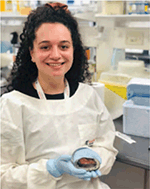
|
Jacinta Agius and Karla Helbig
Department of Physiology, Anatomy and Microbiology, La Trobe University, Victoria, Australia
Molluscan herpesviruses infect species of oysters and abalone resulting in mass mortality events that have been witnessed worldwide, including in Australia. Australian abalone are highly susceptible to Haliotid herpesvirus (HaHV-1) with a 90% mortality rate upon infection. Despite the impact of this virus, practical preventative and treatment options do not exist. In this study, an in vivo HaHV-1 infection model was optimised through the successful production of infectious HaHV-1 viral water. It was demonstrated for the first time, that intramuscular poly(I:C) priming has a potential to protect HaHV-1 challenged abalone when compared to phosphate-buffered saline (PBS) primed abalone. This study presents a novel method to prevent HaHV-1 infection in the abalone and therefore provides insight into future immune priming studies.
Examining the movement and diversity of Streptococcus pyogenes mobile genetic elements within remote Indigenous Australian communities

|
Taylah B James and Jake A Lacey
Department of Infectious Diseases at the Peter Doherty Institute for Infection and Immunity, The University of Melbourne, Victoria, Australia
Indigenous communities within remote northern Australia are disproportionately affected by Streptococcus pyogenes (Strep A) infections, with impetigo and immune-mediated diseases persisting at hyperendemic rates. In non-endemic settings, specific Strep A emm types have been linked to specific disease outcomes. However, in endemic settings like northern Australia where multiple emm types circulate, associations do not match those observed in non-endemic settings. We aimed to inform the epidemiology of Strep A disease by investigating the relationships of virulence factors, mobile genetic elements (MGEs) and emm types from two endemic communities within northern Australia via whole genome sequencing. We found virulence factors persisted for three times longer that emm type in each community and were not restricted to a particular serotype. Isolates of the same serotype, sampled from the same date in the same household were found to differ in their accessory genome relating to bacteriophage elements. Phage mobility, particularly phage transduction may be responsible for virulence factors persisting for longer periods in both communities despite the rapid turnover of emm types. We concluded this study provides a strong baseline for future work to re-examine the association of virulence factors and disease presentation.
IFNɤ reduces T3SS effector translocation and suppresses MNGC formation in macrophages infected with Burkholderia thailandensis
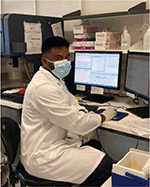
|
Sameer M KhanA,B, Garrett Z NgB and Elizabeth L HartlandB,C
AThe University of Melbourne, Victoria, Australia
BCentre for Innate Immunity and Infectious Diseases, Hudson Institute of Medical Research, Victoria, Australia
CDepartment of Molecular and Translational Science, Faculty of Medicine, Nursing and Health Sciences, Monash University, Victoria, Australia
Melioidosis is an often fatal disease caused by the intracellular pathogen Burkholderia pseudomallei. B. pseudomallei invades the cytosol of host cells using the bsa encoded type 3 secretion system (T3SS), and subsequently spreads intercellularly, causing the formation of multinucleated giant cells (MNGCs). These processes are similar in B. thailandensis, which is used to model B. pseudomallei infection. Interferon-γ (IFNγ) is critical for surviving Burkholderia infection, though how it restricts infection is unclear. Our aim is to examine how IFNγ affects fundamental aspects of pathogenesis: the translocation of T3SS effectors and formation of MNGCs. MNGCs were quantified by counting cells with multiple nuclei. IFNγ stimulated RAW264.7 cells formed fewer MNGCs when infected with B. thailandensis. To assess effector translocation, B. thailandensis strains expressing a BopE- β-lactamase (TEM1) fusion protein were created. Translocation was then quantified by staining infected RAW264.7 cells with the green cellular dye, CCF2, which fluoresces blue when cleaved by TEM1. This revealed that IFNɤ reduced BopE-TEM1 translocation by wildtype B. thailandensis. Confoundingly, IFNɤ increased blue CCF2 signal when a T3SS-deficient B. thailandensis was used, perhaps indicating increased vacuolar instability of the T3SS mutant under IFNɤ stimulation. These results suggest that IFNɤ may inhibit the earliest stages of cellular pathogenesis to suppress Burkholderia infection.
Prevalence of internal parasites in captive dingoes

|
Cecil Wheeler and Richard Bradbury
Federation University, Victoria, Australia
Dingos have the ability to carry zoonotic parasites however, the prevalence of Strongyloides stercoralis is uncertain. The aim of the study was to assess the prevalence of S. stercoralis in a sample of captive dingos. Forty faecal samples were assessed for parasites using Sheather’s sucrose solution egg flotation tests, Koga agars and the Baermann technique. Flotation tests showed eggs of Toxocara canis (15%), Trichuris vulpis (2.5%), hookworm (10%), Taeniids (7.5%), Strongylid eggs (5%) and oocysts of Cytoisospora canis (17.5%) and another Cytoisospora spp. (8%). The Koga plates and Baermann’s sedimentation recovered hookworm larvae but did not identify the Strongylids. The addition of 10 mg/L of amphotericin B to Koga agar was effective in preventing fungal overgrowth and allowed recovering of larvae. The standard Baermann was found to be more effective at recovering hookworm larvae than the modified method. Further investigations using PCR and sequencing to confirm species and larger sample numbers will assist in clarifying the dingo’s status as an intestinal helminth reservoir.
Western Australia
Optimisation of protein crystallisation for X-ray structure determination of FseA, a novel and widespread DNA-binding protein controlling gene transfer throughout the proteobacteria

|
Jake Cummane, Karina Yui Eto and Joshua Ramsay
Curtin Health Innovation Research Institute, Curtin University, Western Australia, Australia
The protein domain-of-unknown-function-2285 (DUF2285) is present in both transcriptional activator and quorum-sensing antiactivator proteins and is widely distributed in the proteobacteria. FseA is a DUF2285-domain protein of Mesorhizobium japonicum that binds DNA and stimulates horizontal gene transfer. FseA shares no sequence similarity with structurally characterised DNA-binding domains, suggesting DUF2285 members represent a new family of transcriptional activators. In this work we purified a maltose-binding (MBP) fusion derivative of FseA, 6H-MBP-FseA, and using size exclusion chromatography confirmed 6H-MBP-FseA was predominantly present as a 150-kDa dimer in solution. Incubation of 6H-MBP-FseA in the presence of its 32-bp DNA-binding target, led to an increase in the molecular weight of 6H-MBP-FseA and confirmed formation of the nucleoprotein complex that can be prepared for crystallisation. The purified 6H-MBP-FseA was used in 96-well crystallisation conditions and fine screening of two conditions. Although the obtained crystals did not diffract at the X-ray beam line, we uncovered new crystallisation conditions that could be further optimised. Optimisation of 6H-MBP-FseA crystallisation will advance efforts to obtain the three-dimensional structure of FseA through X-ray crystallography and provide structural insight into the DUF2285-domain family.
Identifying how the Sil1 nucleotide exchange factor can regulate the permeability of ER translocase in Saccharomyces cerevisiae

|
Merrin Mary Eapen, Mark Bienawski and Carl Mousley
Curtin Medical School, Curtin University, Western Australia, Australia
Sec61 complex is a heterotrimeric translocon on the ER membrane of Saccharomyces cerevisiae. The Sec61 complex gates the movement of GSH through its interaction with Kar2, an Hsp70 protein folding chaperone. Sil1 is a regulator of ATPase activity in Kar2. This project aimed at identifying how the redox state of the endoplasmic reticulum can affect the glycosylation of Sil1 and also examined its effects on the ER membrane permeability. Unglycosylated Sil1 was seen to accumulate in the sss1-7 strain, as its mutation stabilises the Sec61 complex in its open conformation which allows GSH influx into the ER lumen. In order to check how the modifications in GSH concentration can affect Sil1 glycosylation, wild-type cells that over-express HGT1 were incubated in increasing concentrations of GSH, followed by protein extraction and immunoblotting of Sil1. Cells incubated in high concentrations of GSH were seen to accumulate uSil1. In both the cases, GSH influx would have created a reductive stress which then altered the glycosylation of Sil1. This project demonstrates that Sil1 coordinates the regulation of ER membrane permeability in conjunction with changes in its redox environment.
Deciphering the chemical crosstalk between bacterial cell–cell signalling systems

|
Beatrice Alexandra E. Panganiban, Tahlia Bastholm and Joshua Ramsay
Curtin Health Innovation Research Institute, Curtin University, Western Australia, Australia
Bacterial populations detect high cell density using a chemical communication system called quorum sensing (QS). LuxRI-family QS systems produce and respond to membrane-diffusible molecules called N-acyl-homoserine-lactones (AHLs). Diverse LuxR proteins respond to distinct AHL molecules produced by cognate LuxI proteins. The Mesorhizobium MqsRIC system is a novel LuxRI-family system that produces an unsaturated AHL 5-cis-C12-HSL and uniquely requires a second QS-regulated AHL synthesis protein, MqsC. It is unclear how specific the MqsR receptor is for 5-cis-C12-HSL or if other LuxR receptors can recognise 5-cis-C12-HSL. In this work we used bioassay reporter systems to compare specificity of Mesorhizobium spp. LuxR-family proteins MqsR and TraR and the Pseudomonas LasR and QscR. MqsR only responded strongly to 5-cis-C12-HSL, and only slightly to C12-HSL, and to the AHL extracts from Mesorhizobium strains encoding both the MqsI and MqsC proteins. In contrast, LasR and QscR proteins were activated by all C12-length AHLs tested including 5-cis-C12-HSL, but were not activated by C6-HSL. TraR responded to C6-HSL, 3-oxo-C6-HSL and 3-oxo-C12-HSL but not C12-HSL. In summary, the experiments suggest that MqsRIC system is highly specific for the unsaturated 5-cis-C12-HSL molecule, while the LasR, QscR and TraR proteins are less discriminant and recognise a combination of acyl-chain length and third-carbon modification.


